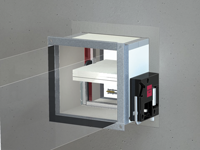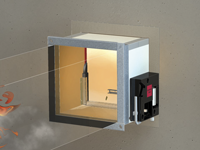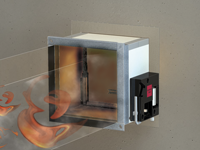Fire dampers are installed where air ducts penetrate fire-resistant compartment walls. Their role is to restore the fire resistance grade of the penetrated wall and to prevent smoke propagation. Fire dampers are distinguished by their degree of fire resistance, by their aeraulic properties as well as by their installation ease. Our fire dampers are all CE marked. They can be equipped with various types of mechanisms depending on the specific needs linked to the project or to the local regulations.
Rectangular Fire-Damper




CU-LT – RECTANGULAR FIRE DAMPER UP TO 120′
CU-LT-1S – RECTANGULAR SURFACE MOUNTED FIRE DAMPER UP TO 120′
CU2 – RECTANGULAR WIDE RANGE FIRE DAMPER UP TO 120′
CU2/B – BATTERY ASSEMBLY FIRE DAMPER



CA2 – RECTANGULAR SURFACE MOUNTED FIRE DAMPER 60‘
CU4 – RECTANGULAR FIRE DAMPER UP TO 240′
CU2-15 – RECTANGULAR FIRE DAMPER 120′ AT 1500 PA
Circular Fire-Damper



CR60 – CLAPET COUPE-FEU CIRCULAIRE OPTIMISE 60-90′
CR120 – CLAPET COUPE-FEU CIRCULAIRE OPTIMISE JUSQU’A 120′
CR2 – CLAPET COUPE-FEU CIRCULAIRE GRAND DIAMETRE
How does a fire damper work?
Fire dampers prevent the spread of fire inside the ductwork that crosses fire-resistance rated walls and floors. They are installed in or on the construction element in order to restore its fire-resistance rating.
The fire damper blade is open when the ventilation system is working. They close automatically thanks to the fusible link when the temperature in the duct exceeds a certain threshold: generally 72°C. In remote-controlled and motorised models, they can also close upon receiving a signal sent out by the fire safety system when it is activated by a smoke detector, for example. When closed, the fire damper maintains compartmentation during a guaranteed period.
- The ventilation system is working and the fire damper is open.

- A fire breaks out and the temperature reaches 72°C: the fusible link melts and the damper blade closes.

- The intumescent material expands to create a seal that stops flames and smoke.

